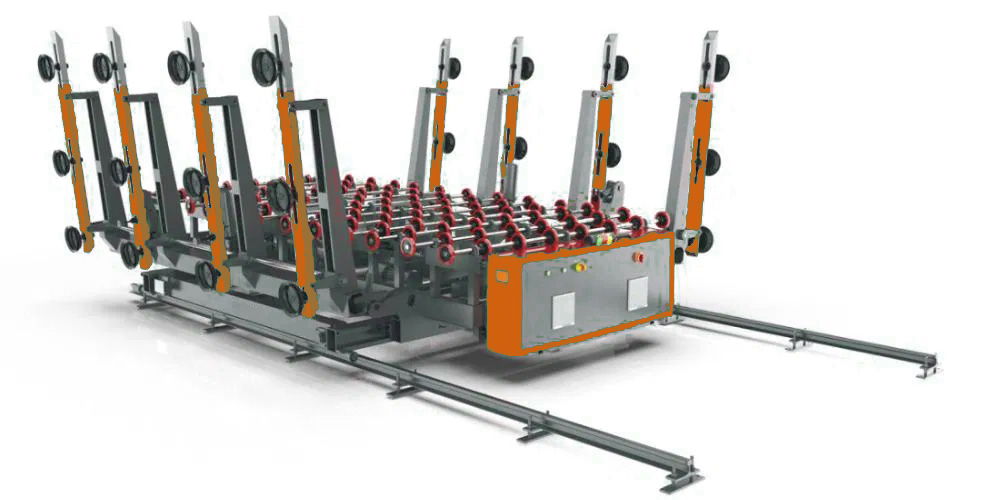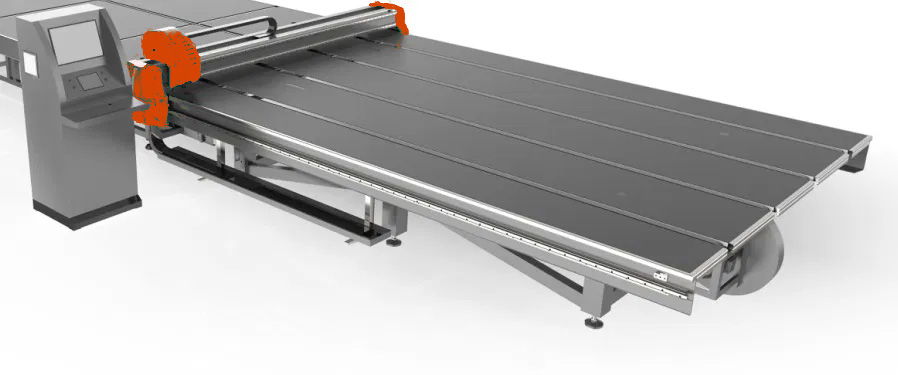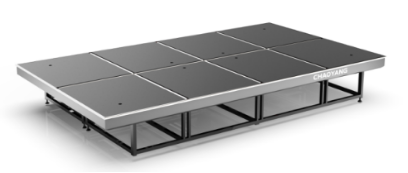Automatic Glass Cutting Equipment
Choisir la machine de découpe de verre automatique adaptée est une décision cruciale pour tout fabricant de verre. Face à la multitude d'options disponibles sur le marché, chacune promettant précision, rapidité et performance, il peut être difficile d'identifier l'équipement qui répond réellement à vos besoins de production. Ce guide vous présente les facteurs clés et quatre étapes éprouvées pour vous aider à acquérir le meilleur équipement de découpe de verre pour votre atelier ou votre usine.
Principe de fonctionnement de base
Il est principalement utilisé pour le chargement automatique du verre. Après avoir placé le verre dans la position désignée et donné le signal de chargement, le grand bras tourne d'environ 95 degrés à travers le mécanisme de renversement, et toute la machine commence à avancer. Lorsque le dispositif d'induction sur le petit bras touche le verre, toute la machine s'arrête de marcher et le verre est aspiré par la ventouse à travers le système d'aspiration sur le verre, le moteur de levage du petit bras soulève le verre vers le haut et vers l'arrière d'environ 80 mm. Le moteur de marche recule et le gros bras tombe. Lorsque le bras porteur est en place, la ventouse sous la vitre commence à souffler. Lorsque le petit bras tombe, le verre tombe sur la roue du convoyeur. Enfin, le verre est acheminé vers la table de découpe par la roue de convoyage.
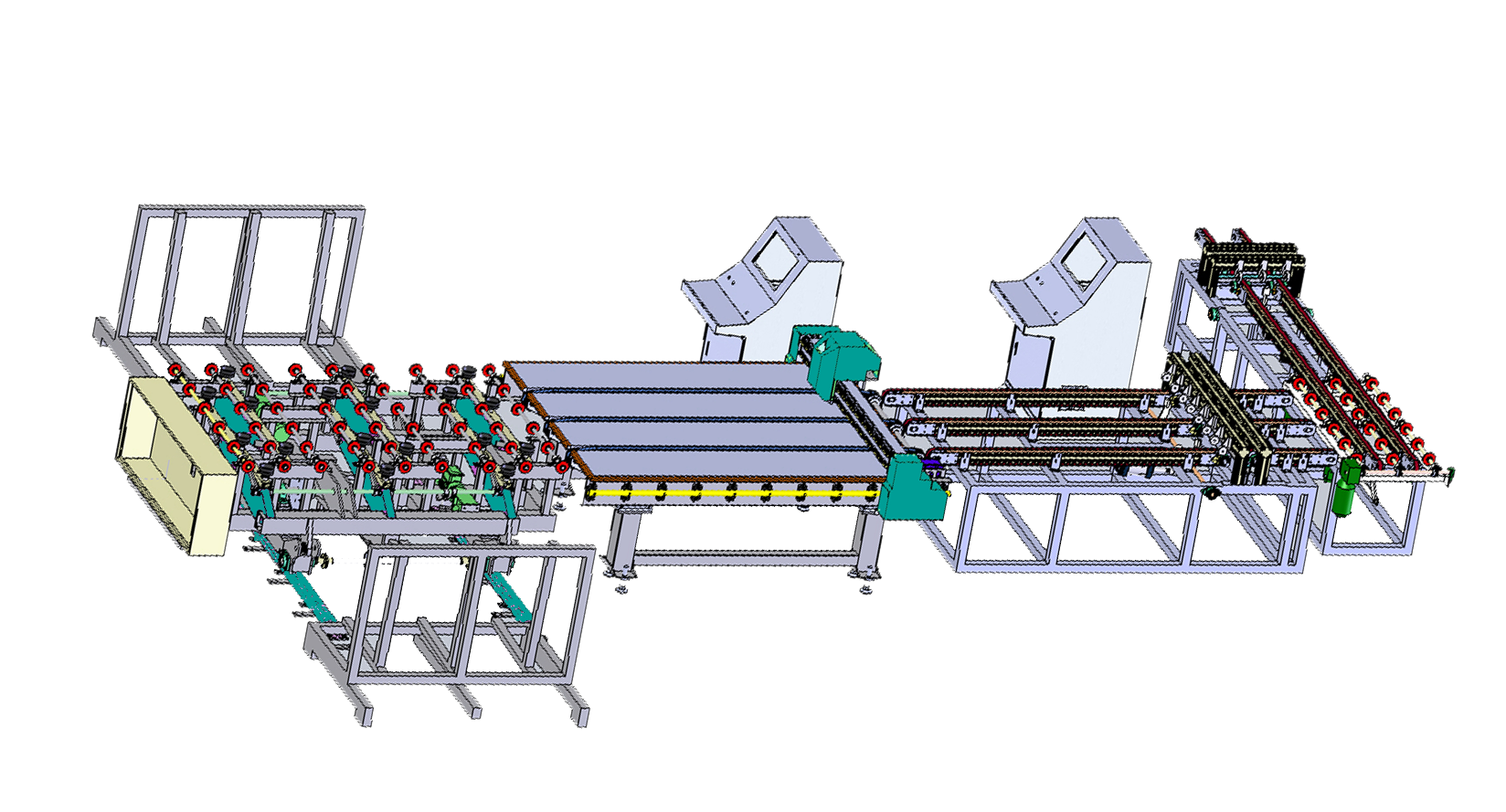 Ligne de connexion d'alimentation, de coupe et de rupture de verre entièrement automatique
Ligne de connexion d'alimentation, de coupe et de rupture de verre entièrement automatique
 Ligne de connexion d'alimentation, de coupe et de rupture de verre entièrement automatique
Ligne de connexion d'alimentation, de coupe et de rupture de verre entièrement automatique Étapes de travail détaillées
L'ensemble du processus de travail peut être réalisé par automate programmable industriel (API) ou manuellement. Le mode manuel est principalement adapté au réglage et à la maintenance des équipements.
Chaque action peut être effectuée indépendamment ou peut être utilisée pour un travail normal. Après avoir donné le signal de chargement (manuel et automatique), le bras tourne vers le haut d'environ 95 degrés grâce au mécanisme de renversement et toute la machine commence à avancer.
Lorsque le dispositif d'induction du bras touche le verre, la machine s'arrête. Le système de vide fonctionne : le verre est aspiré par la ventouse. Lorsque la pression de vide atteint la pression de consigne, la pompe à vide s'arrête. Le mécanisme à bielle télescopique de la ventouse soulève le verre de 80 mm grâce au moteur de levage du bras.
Après un arrêt d'environ 1,5 seconde pour s'assurer que le verre est bien aspiré, le grand bras, entraîné par un moteur, ramène le verre vers le rouleau de transmission. La ventouse sous le verre commence à souffler, et le mécanisme de la bielle télescopique fait tomber la ventouse et le verre simultanément.
Lorsque le verre tombe sur le rouleau convoyeur, le petit bras continue de tomber, le verre est séparé de la ventouse et le convoyeur commence à envoyer la feuille de verre à l'extrémité avant de la machine de chargement et s'arrête au point de signal. Ensuite, l'ensemble du cadre se déplace automatiquement pour trouver la position zéro et s'arrête.
En attendant le signal de la table de découpe, le verre est acheminé vers celle-ci à la même vitesse que le convoyeur de la machine. Une fois le verre envoyé, le cycle de travail se répète automatiquement. La machine peut sélectionner n'importe quelle position en fonction de l'épaisseur de verre requise.
Chaque action peut être effectuée indépendamment ou peut être utilisée pour un travail normal. Après avoir donné le signal de chargement (manuel et automatique), le bras tourne vers le haut d'environ 95 degrés grâce au mécanisme de renversement et toute la machine commence à avancer.
Lorsque le dispositif d'induction du bras touche le verre, la machine s'arrête. Le système de vide fonctionne : le verre est aspiré par la ventouse. Lorsque la pression de vide atteint la pression de consigne, la pompe à vide s'arrête. Le mécanisme à bielle télescopique de la ventouse soulève le verre de 80 mm grâce au moteur de levage du bras.
Après un arrêt d'environ 1,5 seconde pour s'assurer que le verre est bien aspiré, le grand bras, entraîné par un moteur, ramène le verre vers le rouleau de transmission. La ventouse sous le verre commence à souffler, et le mécanisme de la bielle télescopique fait tomber la ventouse et le verre simultanément.
Lorsque le verre tombe sur le rouleau convoyeur, le petit bras continue de tomber, le verre est séparé de la ventouse et le convoyeur commence à envoyer la feuille de verre à l'extrémité avant de la machine de chargement et s'arrête au point de signal. Ensuite, l'ensemble du cadre se déplace automatiquement pour trouver la position zéro et s'arrête.
En attendant le signal de la table de découpe, le verre est acheminé vers celle-ci à la même vitesse que le convoyeur de la machine. Une fois le verre envoyé, le cycle de travail se répète automatiquement. La machine peut sélectionner n'importe quelle position en fonction de l'épaisseur de verre requise.
Paramètre technique
- Taille de la feuille : taille minimale : 2 400 x 1 500 mm (chargement d'un seul côté)
- Taille maximum de chargement : 6100* 3300 millimètres
- Épaisseur de feuille de verre : 3 ~ 19 mm
- Profondeur d'absorption de travail : 700 mm
- Vitesse de marche sur l'axe X : 5-25 m/min (réglable)
- Vitesse de marche sur l'axe Y : 8-12 m/min (réglable)
- Vitesse de transport : 5-25 m/min (réglable)
- Nombre de bras rabattables : 12 bras (chargement double face)
- Nombre de ventouses à bras unique : Trois
- Type de chargement : chargement double face
- Cycle de travail : 60 S (30 S pour chaque position supplémentaire)
- Alimentation électrique de l'installation : AC 380 V/50 Hz (des circonstances spéciales peuvent être ajustées en fonction des exigences du client)
- Puissance totale de l'installation : 8-17 kw
- Air comprimé : 0,6-0,8 MPa ;
- Vide : -50-99 Kpa (réglable selon l'épaisseur du verre)
- Hauteur table de travail : 900 + 20 mm
- Taille de machine : 4650*2980*900 millimètre
Description technique
- The alarm system: with reliable vacuum detection device, to appear abnormal situation can be automatic alarm and display, can be used to control when abnormal and confirmed The vacuum alarm when abnormal and guarantee under the glass in the vacuum state; When the emergency stop to ensure the vacuum suction cups in a glass in the vacuum state, avoid Avoid glass damage due to abnormal downtime;
- The operation pattern: the device has automatic mode and manual mode two functions for selection, operation convenient and intuitive;
- The operating interface: LCD touch-screen display, Chinese display, convenient operation;
- The main frame, and steel structure all use international quality rectangular pipe compound links and bolt assembly; Rectangular steel tube thickness: over 3-8 mm;
- The material of the machine has been aged, the surface has been rust-removing technology to remove rust spots and surface oxide layer, the bottom layer has been sprayed with high-grade epoxy primer, and the surface has been sprayed with high-gre automobile paint.
 Fully automatic glass feeding, cutting and breaking connection line
Fully automatic glass feeding, cutting and breaking connection line Principe de fonctionnement de base
Son principe de fonctionnement consiste à transporter le verre découpé jusqu'à la table de travail par une bande transporteuse, à saisir automatiquement la position du verre grâce à un système de balayage photoélectrique, puis à déplacer la tête de coupe avec meule diamantée sur le porte-outil selon les axes X et Y, commandée par programme, pour couper la feuille. La machine est équipée d'un contrôleur de mouvement CNC et d'un servomoteur à courant alternatif de pointe pour l'entraînement.
Étapes de travail détaillées
- The chassis material is welded and formed by the national standard manganese-containing section bridge steel (Q345A) after aging treatment. The comprehensive mechanical properties, plasticity and welding properties of this kind of steel are good. The frame is processed as a whole, and the stability and accuracy of the equipment are greatly improved by tempering aging treatment to ensure the stability of the product. After special rust removal process, the surface rust spots and oxide layer are removed. The top coat is sprayed with high-grade epoxy primer and the top coat is sprayed with high-grade automobile paint.
- Through the analysis of professional structure software, the equipment ensures the stability, dynamic balance, mechanical strength to achieve the most perfect match, and ensures that the structure of the table is not deformed.
- The device has one key reset function. It can complete all the preparations before starting automatically by clicking on the touch screen, which greatly improves the work efficiency.
- Reasonable arrangement of integral cables and gas pipes and complete sealing
- High-speed silent linear guide is adopted for guide rail, which has high cutting accuracy and low noise.
- Advanced Japanese Ankawa servo motor is used in the driving part, which makes the equipment reliable, error small and efficient.
- Japanese SMC proportional solenoid valve is used for cutting rice. The pressure is automatically adjusted according to the glass thickness. The cutter head rotates 360 degrees, and the upper and lower buffering cutter cuts (any straight line and all kinds of special shaped glass can be cut accurately).
- The knife head is equipped with knife protection function. If the knife head falls outside the glass or the glass gap, the program stops automatically, effectively preventing damage to parts and glass.
- Double motor high speed drive (large inertia Yaskawa servo) ensures cutting speed and fluency;
- Conveyor device, synchronous automatic transmission device, convenient for glass upper and lower transmission, frequency conversion speed regulation, stable and easy to optimize the transmission speed;
- Positioning device, photoelectric scanning positioning system;
- Compensation function, tool eccentricity compensation, clearance compensation, pitch compensation.
Paramètre technique
- Taille maximale : 6100×3300 mm
- Épaisseur : 3 à 19 mm
- Précision de coupe : ±0,30
- Précision de coupe du verre de forme spéciale : ±0,35
- Vitesse de coupe : 0-200 m/min
- Vitesse de transport : 0-25 m/min
- Taille de la machine : 6800 × 4100 × 1500 mm
- Hauteur de la table de travail : 900 mm±20 mm
- Poids : 2600 kg
- Puissance totale de l'équipement : 9-15 kW
Description technique
Partie logicielle :
Contrôleur de mouvement :
Logiciel d'optimisation :
Contrôleur de mouvement :
- Vitesse de fonctionnement rapide, fonctionnement fluide, haute précision de contrôle, structure de contrôleur modulaire ;
- L'interface homme-machine est simple et généreuse, le réglage des paramètres est simple, les paramètres à modifier par les opérateurs sont moins nombreux, simples et intuitifs, et les exigences pour les opérateurs sont faibles.
- Les modes de coupe par pipeline, de positionnement photoélectrique et de coupe directe sont librement définis via les options. Les modes de coupe automatique et pneumatique peuvent être commutés à tout moment pendant l'usinage.
- Programmation d'imbrication de bibliothèque graphique, sélection de formes spéciales dans la bibliothèque, définition des paramètres pertinents, quantité de traitement, imbrication automatique, génération de trajectoire de traitement ;
- Stockage complet du stock de pression de verre, une fois la pression de coupe de chaque épaisseur de spécification saisie et enregistrée, elle peut être directement invoquée ;
- Suivi et affichage en temps réel du chemin de traitement, enregistrement en temps opportun des coordonnées de mouvement, de l'état de l'axe, de l'état des E/S, enregistrement automatique du diagnostic de défaut et de l'alarme ;
- Recevez une variété de documents de traitement, acceptez le code G standard d'Optima, le logiciel Super Package, le fichier AUTOCAD DXF, le système possède son propre logiciel d'édition graphique (exactement le même que la méthode d'édition de Paul) ;
- Programmation d'imbrication de bibliothèque graphique, sélection de forme anormale dans la bibliothèque, définition des paramètres pertinents, quantité de traitement, imbrication automatique, génération de trajectoire de traitement ;
- Fonction de tri des fichiers DXF, incluant le point le plus proche, le point d'entrée, ou le tri par couleur graphique (sens horaire ou antihoraire) et d'autres options. Le basculement entre la découpe monophasée et bidirectionnelle est possible.
- Fonction de positionnement photoélectrique, en fonction de la position réelle et de l'angle de déviation, ajuste automatiquement la coupe ;
- Fonction de compensation : compensation d'excentricité de l'outil, compensation de jeu, compensation de pas ;
- Tous types de protection : y compris limite douce et dure, limite de pression de coupe, contrôle d'arrêt d'urgence externe, etc.
Logiciel d'optimisation :
- Résultats d'optimisation importables réalisés au bureau
- Le schéma de coupe peut être créé et modifié manuellement
- Avec fonctions de copie et mobiles
- Édition manuelle de la séquence de coupe
- Le schéma de découpe peut être rapidement créé par les modes X, Y et Z.
- Optimisation simultanée de plusieurs correctifs originaux et de petite taille
- Composition optimisée sans limitation de taille
- Rotation des résultats optimisée, gestion des miroirs, etc.
- Gestion des priorités pour l'optimisation des découpes de petite taille
- Gestion prioritaire de l'optimisation des feuilles de verre d'origine
- Fonction de numérisation de modèles et traitement des graphiques de numérisation
- Gestion du stockage des feuilles de verre d'origine
- 20 algorithmes d'optimisation efficaces
- Les graphiques de découpe peuvent être modifiés
- Conception et impression d'étiquettes (Label-WAY)
- Impression claire du rapport de résultats optimisé
- Importation de fichiers de données Excel
- Gestion de la découpe du verre à faible émissivité et du verre adhésif
- Une bibliothèque graphique contenant 350 graphiques paramétriques, y compris tous les types de graphiques couramment utilisés (Geo-Way)
- Système de CAO bidimensionnel avec fonction de traitement de nu
Principe de fonctionnement de base
Partie électrique:
、Contacteurs : Renmin/Zhengtai
、 Disjoncteur : Renmin/Zhengtai
、Bouton : Renmin/Zhengtai
、Électrovanne principale : Airtac
、Autres composants pneumatiques : Deke/Shengguan
、Ventilateur : Liyuan
Partie mécanique;
、Table de travail : plaque haute densité étanche
、Table : Feutre industriel importé (noir)
、 Barre de rupture : bois massif (couleur naturelle)
Remarque : En fonction de la date de livraison et de l'amélioration technique, la société de production se réserve le droit de remplacer les pièces achetées de la même marque.
、Contacteurs : Renmin/Zhengtai
、 Disjoncteur : Renmin/Zhengtai
、Bouton : Renmin/Zhengtai
、Électrovanne principale : Airtac
、Autres composants pneumatiques : Deke/Shengguan
、Ventilateur : Liyuan
Partie mécanique;
、Table de travail : plaque haute densité étanche
、Table : Feutre industriel importé (noir)
、 Barre de rupture : bois massif (couleur naturelle)
Remarque : En fonction de la date de livraison et de l'amélioration technique, la société de production se réserve le droit de remplacer les pièces achetées de la même marque.
Étapes de travail détaillées
- Fonction de prélavage ;
- Positionnement automatique précis pour les DGU à 3 marches latérales ou les IGU à 4 marches latérales ;
- Le remplissage automatique de gaz argon pourrait définir la valeur du gaz et afficher le processus de dépôt en ligne avec une concentration de gaz élevée.
Paramètre technique
- Barre de rupture : type 3+1
- Taille de Tableau : 6300*3500 millimètre
- Épaisseur du verre : 3-19 mm
- Puissance : 8kW
- Hauteur de table : 900 + 20 mm
Description technique
Croquis de conception
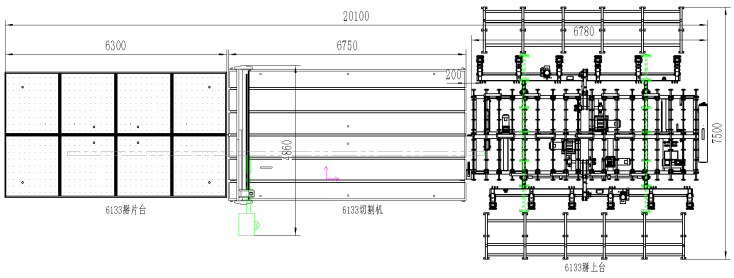 Ligne de connexion automatique de la table de bris de verre flottant à l'air
Ligne de connexion automatique de la table de bris de verre flottant à l'air
 Ligne de connexion automatique de la table de bris de verre flottant à l'air
Ligne de connexion automatique de la table de bris de verre flottant à l'air 